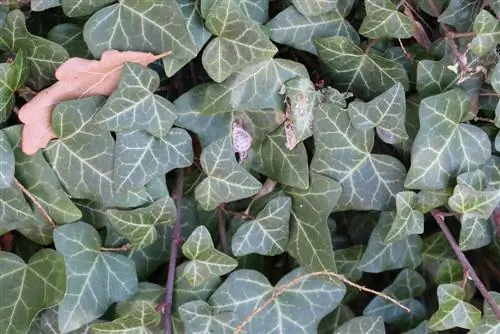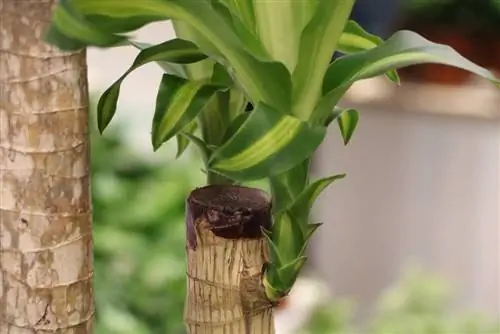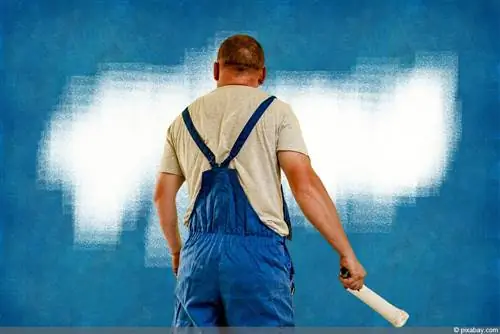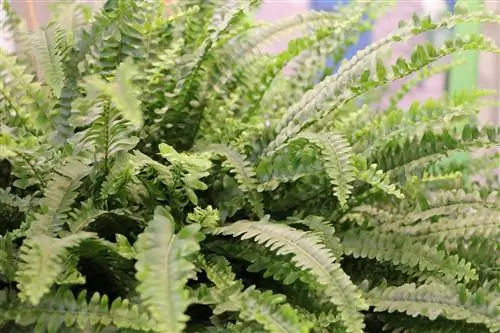- Author admin [email protected].
- Public 2023-12-17 03:39.
- Last modified 2025-01-24 12:45.
Houseplants placed in the apartment not only bring a touch of exclusivity, they also convey coziness and homeliness. But if you bring houseplants into your home, you should pay attention to the right location so that they thrive.
A dark location is sufficient for many houseplants
The living atmosphere can be significantly lightened up with beautiful house plants. They bring a nice sense of cosiness to rooms large and small. But in order for the plants to grow and thrive, they obviously have to be in the right place. There are plants that love sunny locations and those that prefer to be in dark corners, hallways or dark room niches. The cobbler palm, ivy, nest fern, green lines and the philodendron are ideal for these dark locations and rooms. Although these plants also thrive in the shady south-facing window, they also do well in dark corners. The shoemaker's palm gets its name because it used to be often found in dark commercial spaces such as butchers or shoemakers. The spider plant is ideal for drafty places and stairwells. Botanically it belongs to the room oat and is considered a typical office plant. The diligently blooming flaming Käthchen is also one of the insensitive plants that likes to stay in the dark. Occasional errors in care do not affect the aforementioned plants.
Typical symptoms that the houseplant does not feel comfortable in its location are long and thin shoots and sparse growth. This also includes the loss of leaves for no apparent reason. Many plants that show this “disease” are usually in a north-facing window where the light is not good. But that doesn't mean that planting is not possible in this location, you have to choose the right candidate. A lush abundance of flowers should not be expected in dark locations, but a lot of leaves should be expected. The ivy, with its variegated form, practically explodes on a north-facing window. The ivy plant, which has nothing to do with ivy, also feels comfortable in the cool shade. The climbing ficus, room ferns, aralia, the room wine and the beautiful basket marantulas also live in dark locations and rooms.
Artificial light sources for dark rooms
Ferns in particular love locations that are too dark for other plants. Since ferns are forest dwellers, they get by with little light. The tropical species, which love warmth all year round, are perfect residents for dark bathrooms, hallways and kitchens. Sometimes shadow lovers also hang their heads when the room is really too dark. This problem can be helped with artificial light sources. There are so-called plant lights that can be attached near the plants. They provide enough light so that other plants that prefer semi-shady locations can also find their place there. These include, for example, indoor aralia, single leaf, Russian wine, Schefflera and the dragon tree. It is said about the location of houseplants that it should adhere to their geographical origin. Experts say the darker the leaf green, the more the plant prefers to be in dark corners. The reason: darker leaves have more leaf green grains, which means they can absorb light better. What houseplants don't like at all are rooms with sharply changing day and night temperatures or drafty rooms. Hanging and falling leaves are the result.
Palm trees are undemanding houseplants
So if you have a dark apartment that faces north and therefore absorbs a lot of light, you should pay attention to the selection of your houseplants. The coleus can be placed on a north window. If this coleus is in the dark, it can really develop its colors and shapes. If you want to beautify your dark hallway with plants, you can also use a Yucca palm or a Ficus Benjamini. These plants tolerate shade very well. They thrive particularly well when a few rays of sunshine shine into the room during the day. Even shade-loving plants need some light to survive. In general, palm trees are undemanding plants that tolerate a dark location and are also easy to care for. These include the mountain palm, the Kentia palm or the rhapsis.
Here is an overview of shade-loving plants:
- Cobbler palm (formerly called butcher palm)
- Dragon Tree
- Ivy
- Ferns
- different types of begonias
- Zimmeraralie
- Chestnut wine
- Harp bush
- Goldblatt
Care for shade plants

For plants that like to be in the dark, it is important that dust does not accumulate on large leaves, as this hinders the absorption of light. Smaller pots should be rinsed with lukewarm water from time to time. Larger plants love to be wiped with a damp cloth. You can water and fertilize sparingly, because where it is dark, a plant grows slowly. As a result, their need for nutrients and water is low. Some of the more unusual species include plants whose foliage is variegated. These plants need more light. For example, if you want the white-green color to remain with the ivy, you should put it in a slightly brighter place.
In general it can be said that colorful foliage plants need more light than the purely green ones. Since the shade plants that grow in the dark grow slower, they don't need to be repotted as often. The cooler and the darker a plant is, the less water it evaporates and too much nutrients can do more harm than good. You can swap houseplants that need some light from time to time so that there is always a beautiful plant in dark corners. Many plants feel comfortable not only in dark rooms, but also when they are cool, such as a hallway or a porch.
Dark-loving and hardy houseplants:
- Elephant foot
- Kalanchoe (Madagascar bell or flaming cat)
- Yucca palm
- bow hemp
- Dragon Tree
- Efeutute
- Green Lily
- rubber tree
What you need to know about houseplants for dark locations
There are appropriate houseplants for every room and every corner, no matter how dark it is. If you give the plant its right location, it will also thrive in dark niches and hallways. Attention should be paid to the needs that the plants need so that they can be shown to their best advantage even in dark locations and rooms. For example on north-facing windows: You shouldn't expect a lush abundance of flowers here, but there are definitely a lot of plants that feel right at home there.
- Climbing Ficus
- Indoor Ferns
- Aralia
- Basket Maranten
- Room wine
These leafy beauties are also joined by some shade-tolerant bloomers: African violets, the wax flower, busy lilies, hydrangeas, fuchsias and the moth orchid. However, plants with the problems mentioned at the beginning are better off moving to a brighter east or west window. There they recover quickly.
Sensitive plants indicate a lack of light with the following symptoms:
- leaffall
- weak horny shoots
- Leaves stay small
- Greening variegated plants
- Top shoot stunted
- Flowering plants form few or no buds
Countermeasures for lack of light:
- Pull back curtain
- Move plants as close to the window as possible
- Change of location, for example from the north window to a bright location
- attach a special plant light
Tip:
Dust absorbs a lot of light. Therefore, clean windows more often.
Basically, all plants need as much light as possible according to their nature. If the lighting conditions are not correct, improve the location or install a special plant light. Sunlight from the socket: If there is not enough daylight, plant lights can provide sunshine free of charge. With at least 3,000 lux even in windowless rooms. In winter, additional lighting is particularly useful in heated rooms. The plants cannot slow down their metabolism here, for example in cool rooms.
Measuring light intensity: A luxumeter answers the question of whether a plant feels more comfortable here or there. It shows how much light falls on the area and can therefore determine the best place.






